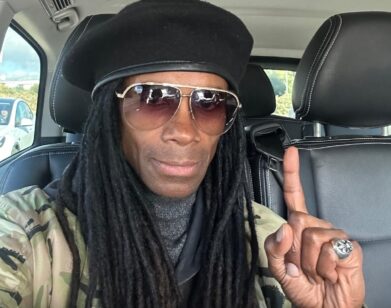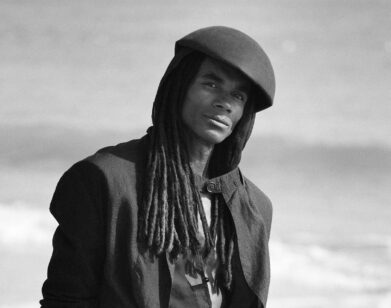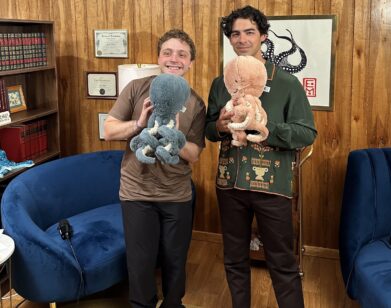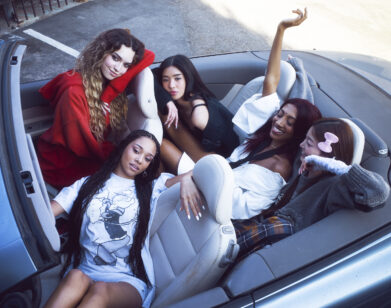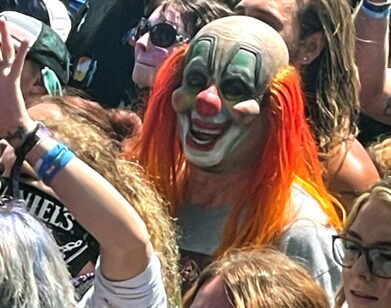Lee Ranaldo’s Perfect Storm
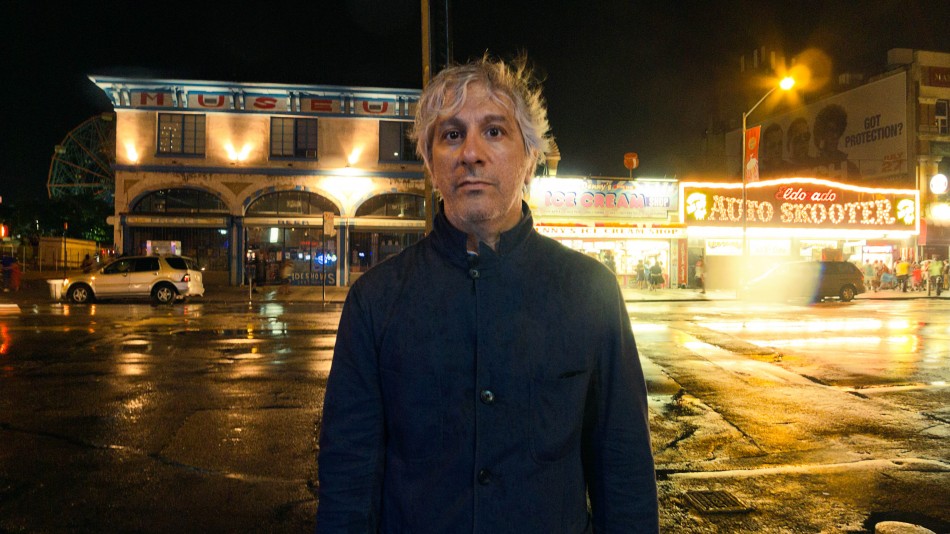
ABOVE: LEE RANALDO. IMAGE COURTESY OF LEAH SINGER
“The last thing we saw—before the light hit the night—is now scattered in time,” muses Lee Ranaldo on the title track of his second solo record. Aptly entitled Last Night on Earth, the former Sonic Youth guitarist’s new project is a foray into expansive instrumental territory with his band The Dust, including veteran Sonic Youth drummer Steve Shelley. With their bleak, pained lyrics, Ranaldo’s songs retain a poignancy characteristic of an intimate acoustic record.
One could look at Ranaldo’s work as an extension of Sonic Youth’s studies in spatiality and depth, although he expands into otherworldly, even supernatural territories. Last Night on Earth claims its roots in both the anticipation and the wake of a natural disaster—Ranaldo found himself recording ghostly wind patterns and shivering trees during the impending gloom of Hurricane Sandy. The songs on the record materialized out of the blackness that hung over a dim New York, and amidst the fragmented debris and apocalyptic conditions that had swept throughout lower Manhattan, Ranaldo began to thread together songs like “Last Night on Earth” and “Blackout.” A fascination with stringed instruments also punctuated the development of the record, and “Late Descent No. 2” finds the singer experimenting with harpsichord amidst a steady rock record.
Over the phone, Ranaldo chatted with us about science fiction novels, exploring his newfound role as a frontman, virtual reality, and an enlightening trip to India.
PAULA MEJIA: What headspace were you in writing Last Night on Earth? Was it drastically different than Between the Times and the Tides, or surprisingly similar?
LEE RANALDO: Well, the Between the Times and the Tides came about as a surprise, to me. Sonic Youth was in a downtime period, before all the upheaval with Thurston and Kim was even revealed to we within the band, let alone the public. And we had written The Eternal, had toured a lot for that and had taken some time off to work on individual projects, and it had been a while since any songwriting had happened. Sonic Youth has always been the vehicle for my writing, you know, because it’s a collective songwriting entity, we write our songs as a group. I suppose in some way I was missing the very particular process that is writing songs as opposed to playing abstract music. I was pretty engaged at the time in all this other kind of playing, but somehow I started fooling around with acoustic guitars and songs started popping out. Having nothing else to do with them, I just started completing them one at a time and started watching it happen.
It really started with one song from that last record, “Lost,” when I was invited to join an acoustic performance in the south of France. I kind of reluctantly agreed to do it and just figured I would play a bunch of different tunes. I’ve always been an acoustic player, but it’s something I’ve very rarely done in public until recently. Something magic happened then when I was rehearsing for that show—that song popped out, then two weeks later I performed. Seeing that process actualize—something isn’t there, then it is—allowed for all these songs to happen. I thought I’d make a simple acoustic record; it became much more than that, Between the Times and the Tides. The sort of new fascination with playing acoustic guitar and finding these songs in different tuning has kept up. The interesting thing is that while making the record, I was just thinking about the songs. I never thought about the possibility of performing them live at some point, or putting a band together. A year later, having toured a bunch in the U.S., Europe and Australia with the band, I felt much more comfortable with a band. And I knew from the beginning that it was going to be much more of a band’s process. I was still writing the songs at home on acoustic guitar, but it had become a pretty interesting vehicle with what I had been trying to get at.
For the last record, I laid out the tracks with Steve [Shelley] and a bass player, with a rhythm section, and then had a bunch of different people, like John Medeski, come and layer on top of them. This record, I brought the songs to the songs to the band early and we spent the better part of the winter just wood-shedding the songs, playing them a lot, really working on band arrangements. That’s probably the biggest difference; this record is more expansive musically, there’s a lot more open-ended playing, and going in a nice direction from where I stand right now, from songs opening up to the band itself.
MEJIA: The record does sound fuller, although I noticed that thematically it’s very sparse at times. The title itself conjures a sense of an oncoming apocalypse.
RANALDO: It’s kind of funny, in spite of the title, it wasn’t meant to be an apocalyptic record. Some of the songs had their beginnings in the week after Hurricane Sandy and the subsequent blackout in lower Manhattan. We were without power and lights and electricity for most of a week, and there wasn’t much to do in the evenings. So I ended up playing my guitar a lot and laying some songs down—”Last Night on Earth” and “Blackout” popped out. A lot of the songs have been in process with scraps for a long time, and I didn’t finish a lot of the lyrics until the very end. When I started looking back, when I noticed there was a bit of a bleak quality to a lot of them. That surprised me. I wasn’t going for something like that, but who knows? Winter could have something to do with it; the storm, to a degree. I’m still kind of figuring out what that’s all about. I don’t think the music itself is bleak; it was never my intention to make it bleak.
But the song “Last Night on Earth” came out of those days after Hurricane Sandy, walking around in my neighborhood at night, no streetlights, no lights inside the window, just completely dark and with shadows. It was pretty eerie. My rationale of that song is more of a science fiction story, something like Cormac McCarthy’s The Road. It’s more of a hypothetical situation, in a sense.
MEJIA: It’s funny you mention science-fiction novels. I noticed there’s a delicacy about the way you address impending doom, rising tides and sparse landscapes that are very similar to the descriptions in works like Brave New World and 1984. Do any of those apocalyptic stories resonate with you?
RANALDO: I don’t read that much science fiction these days, but I was really, really into science fiction in my youth. I read tons of, you know, what they now call the Golden Age, like Isaac Asimov and Robert Heinlein and Theodore Sturgeon. And later, you know, Philip K. Dick and William Gibson, people like that. I read a lot of science fiction and it’s ingrained, in a certain way, and I’ve been very involved with Kerouac and the Beats, but before that it was a lot of science fiction. A certain aspect of that is very deep with me, but I don’t know if I point to that really influenced this record. Although I do love William Gibson; he’s the one sci-fi writer whose books I still continue to read. It’s either about the present day or the very near future as opposed to, say, 2000 years from now. His take on things is always very interesting to me, very informing.
MEJIA: I’m not familiar with Gibson, but I do think that the most frightening—and compelling—of those science fiction novels are the ones that are about the near or impending future, as they feel very real.
RANALDO: You’ve got to read Gibson, then, and start with Neuromancer; it’s such an amazing book, it’s about the near future, but also happening right before our eyes. It’s fiction becoming reality, in a way.
MEJIA: In that sense, is the apocalypse or the doom of the impending future something you think about actively?
RANALDO: It’s a great subject for books and movies and stuff like that. But no, I don’t find myself consciously contemplating that too often too heavily unless there’s something heavy going on. [laughs] If anything, I think it’s something that comes up in light of mortality instead of apocalypse. The world is going to end for each of us in a prescribed time, and you sort of understand that your time is limited at a certain point, and you want to get done the things you want to get done. You don’t want to leave things undone, because you only have a limited amount of time. I’m always motivated by those kinds of thoughts.
MEJIA: Say you were told it was your last night on earth. How would you spend your time?
RANALDO: Well… I think, most likely, I’d want to spend it with my family and my kids. I think in the song, the protagonist spends it either with the one he loves or making love, that kind of thing. I don’t think I’d be jetting off to see some sight I didn’t get to see in my lifetime. It’s best to keep it simple. [laughs]
MEJIA: It makes sense. In times of tragedy or confusion, we all turn to our loved ones. I don’t know of many people who would go to, say, Bali instead.
RANALDO: Yeah. Although for many, many, many years—and I’ve never been—I was dying to go there. I’m so engaged with the music there, and it’s one place that I would love to still go to some day. I actually just got back from India a few days ago. I played three shows in India, believe it or not, and it’s another place. I definitely wouldn’t choose to go there on my last night on earth—it’s too overwhelming! But it was quite a trip to have the opportunity to go there and see some of the country.
MEJIA: I’d imagine. Did you see anything that struck you in particular?
RANALDO: We were in Delhi and Bombay and we were also in this remote region in the far northeast—and when I say remote, I mean really, really remote. It was the second year that this fledgling Indian rock festival that takes place in this part of India that’s way in the northeast, east of Bangladesh actually, almost in a little peninsula of India. It was definitely the most remote place I’ve ever been in my life. I mean, the nearest town we flew into, we had to drive 16 hours, deep into a jungle, and it was a part of India that wasn’t technically Buddhist or Hindu or Muslim, but animists. The people were tribal and a lot of the different tribes converged there. People are still living in bamboo dwellings there. It was pretty remarkable. It’s next to Tibet and Nepal, under Mongolia, all the people look Tibetan or Vietnamese or Thai. It was all rice patties and bamboo structures everywhere. It was amazing. The stage we played on was all constructed out of bamboo and rope. I had five or six days there, and it was incredible. Quite an experience.
MEJIA: Wow. Was it jarring or peaceful being somewhere so remote?
RANALDO: You felt, as one would expect, quite cut off. We were without phone or Internet for five or six days… and you know, people lead a very simple life there, and so we spent our time exploring what we could. The people in India are wonderful. Everyone was super, super friendly. It felt pretty amazing to be there. But it was so remote that it was astounding, in a certain way. The roads were really bad to get there to begin with, and you realize that something happening it would take a concerted effort to get back to civilization. It was a little bit of an eerie feeling, but also a peaceful feeling at the same time.
MEJIA: Given the state of interconnectivity, it’s becoming much more difficult to cut ourselves off like that, but it’s important to not be stimulated sometimes.
RANALDO: Yeah. It’s definitely a modern-day problem; everyone is stimulated like that. You look out on the street and everyone has their heads in their phones. Nobody’s really looking up at the sky or the buildings and taking the day in. I try to be conscious of it, but everybody falls prey to it.
MEJIA: Coupled with that, people just don’t talk to each other anymore. As someone who relishes conversation with strangers, it’s upsetting that it takes so much for people to have face-to-face conversations anymore.
RANALDO: It’s true. It’s a weird fact of our current life. I have a feeling that it’s one of those things that, at a certain point, will work itself out. Also, there’s a lot science fiction writers who explore that exact problem—virtual reality overtaking actual reality and never having a face-to-face conversation, just through cyberspace. It’s a weird sign of the times.
MEJIA: Or we’ll all just eventually turn into cyborgs, and then our problems with telecommunication be over.
RANALDO: Yeah. [laughs]
MEJIA: Backtracking a bit, you mentioned that the writing and performing process with Sonic Youth was always very organic and collaborative. Now working as a solo artist, how do you work to both motivate and set parameters for yourself?
RANALDO: Well, I’ve been onstage and doing this kind of thing long enough that it’s, to a point, kind of natural. I’d always wanted to make a solo record for one reason or another, because Sonic Youth was occupying my time or whatever, and it never happened. So when these songs started popping out and it became a reality that this record was happening, I wasn’t thinking beyond getting these songs out. All of a sudden we had the record out and it was like, “Oh, you have to go out and play these now.” Also being the front person was a big shift in a certain way—coming from a four-way collaboration to more of a director’s role where I’m dictating what’s happening. Not to say it’s not collaborative right now, but I’m the one writing the songs and with my name on the cover. But I really enjoy singing, and I’m glad I’m getting to do that. I feel pretty confident as a singer and about the songs, and the transition from this band I’d been in for so many years to this one… I think sometimes people come not knowing what to expect, and that’s okay, too. I still do a lot of different kinds of things live.
MEJIA: Speaking of unexpected things, I was caught off guard (albeit pleasantly) by the baroque instrumentals in “Late Descent No. 2.”
RANALDO: Yeah, that one really comes out of left field. It came about in a funny way. When you do a record, you tend to find all these different points of influence that fall into place. And with these songs being more open-ended and expansive and with more room for musical interplay, things I hadn’t thought about in a long time came together, from guitar interplay bands. Certainly music from bands like Television, who were nearly my contemporaries in New York, to a band like The Grateful Dead, that I was into ages and ages ago, before punk rock took over. Some qualities, to me, parallel certain aspects of Sonic Youth’s music, being able to move from song forms to wild, wide-open musical spaces and back. But listening to their music again was compounded when I was asked by a music website to review the Grateful Dead movie about a concert that was filmed in Eugene, Oregon in 1972. In particular I got fascinated with one song on one of their old records, which features prominently a harpsichord. It’s a really amazing song and I was listening to it a lot, it has this very strange baroque quality to it you don’t often find in rock music.
So I was thinking about that song. And then I was asked to write a piece last year for a free ensemble from Berlin, a 14-player group of string players—violin, viola, bass, cello. And they commissioned me to make a work for them. I did, and we premiered it in June, and I’m going to perform it again with another ensemble in Australia in January.
And during the day that Hurricane Sandy hit, before it was predicted to be the part of the real high part of the storm, I was in my house and I started to hear these really weird, eerie sounds coming through the window. It was the wind making these strange—almost like music, chords and clusters of notes and things. I don’t know if you’ve heard of this instrument, the Aeolian harp, but it dates back to Greek times where they would set strings in the wind and let it vibrate the strings, and it would start making sounds. It was kind of something like that—the wind rushing through these narrow cement canyons down here, like fire escapes, was making these really strange sounds. An hour or so before the storm, I went out with a tape recorder—and it was around the time the river was spilling over onto the West Side highway—and I spent about 45 minutes recording these sounds, and came home and transcribed them on piano and then for this string ensemble. I did the piece based on these wind sounds. That’s another way I mined stuff from Hurricane Sandy. It’s hard to predict where you’ll get inspiration, but I built into the piece I built into some songs from the record, “Last Night on Earth” among them, and it goes back and forth between abstract things… I don’t remember why I started telling you about this. [laughs]
MEJIA: It was about the baroque instrumentals…
RANALDO: Oh yeah! So when we premiered this in Amsterdam in June, another piece that another ensemble did on the program included a German woman playing this harpsichord, and it was really beautiful. She was an amazing player, also from Berlin. I was thinking about it, and I had this song “Late Descent” that was kind of sketched out. I didn’t want it to just be me and an acoustic guitar. So I wrote her an email, and asked her if she would try doing something with the songs. And we didn’t really have time for a studio session, and she said she would try, but said “I’m totally a baroque musician, I don’t know anything about pop or modern music.” Harpsichord is tuned differently and it was lower than a concert pitch, and she recorded it with headphones listening to the tune. Then she sent it back to me, we sped it up.
I also wanted to get the band involved, so when we were on tour in Italy, we were playing a concert in an old castle—it was the last minute before the record was due to be in. So really last minute, Steve and Al put headphones on and I had a digital recorder. Steve did a couple of takes with the song, and nothing was really in sync so we had to move everything around to make it work. I wanted it to have a more casual vibe than a studio vibe, and that’s how the harpsichord came to be on that track. I think it has a cool story behind it.
LEE RANALDO’S LAST NIGHT ON EARTH IS OUT TODAY. HE’LL TOUR THE U.S., CANADA, AND EUROPE THROUGHOUT THIS FALL AND WINTER IN SUPPORT OF THE RECORD. FOR MORE ON THE ARTIST, PLEASE VISIT HIS WEBSITE.

